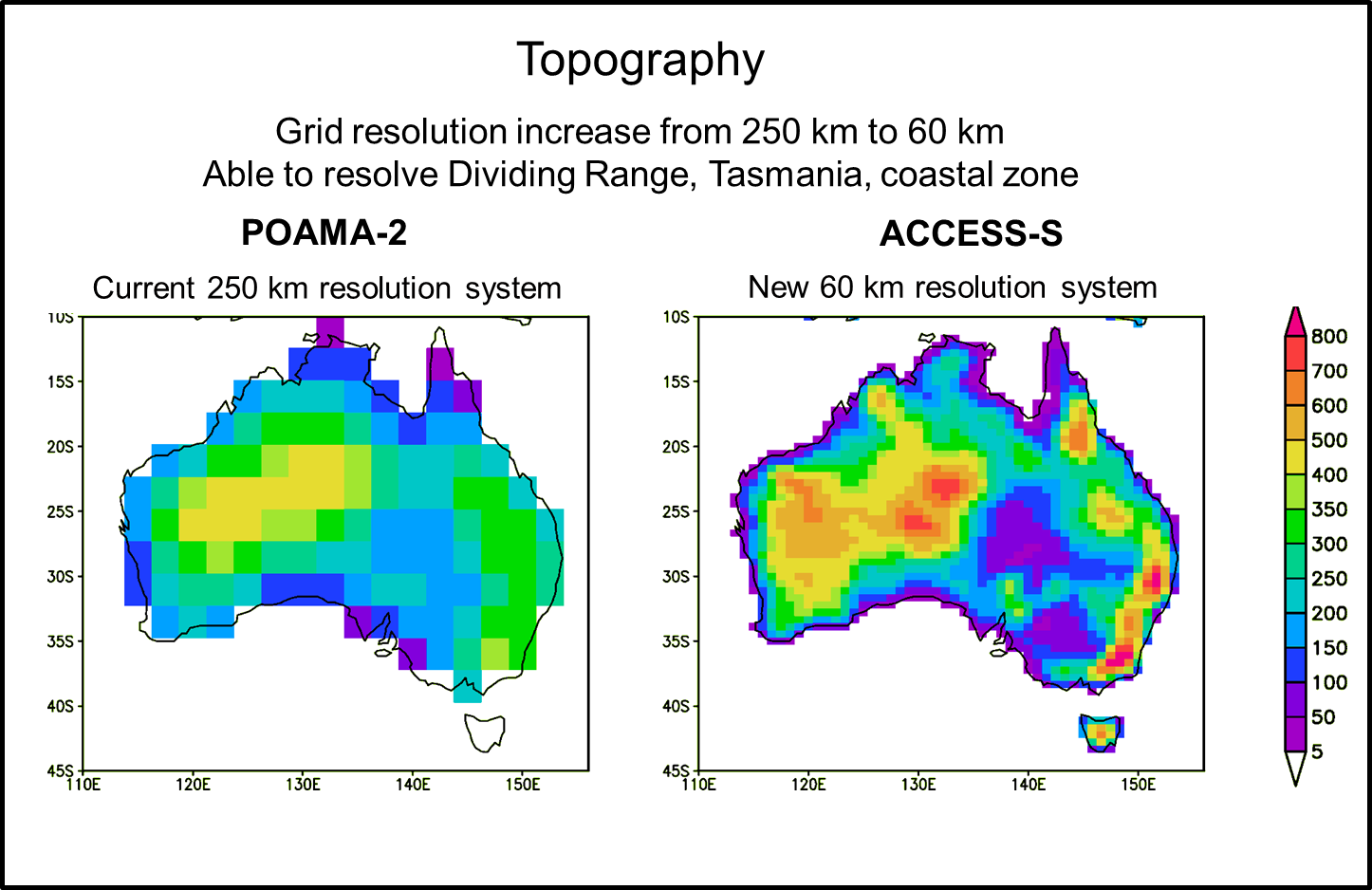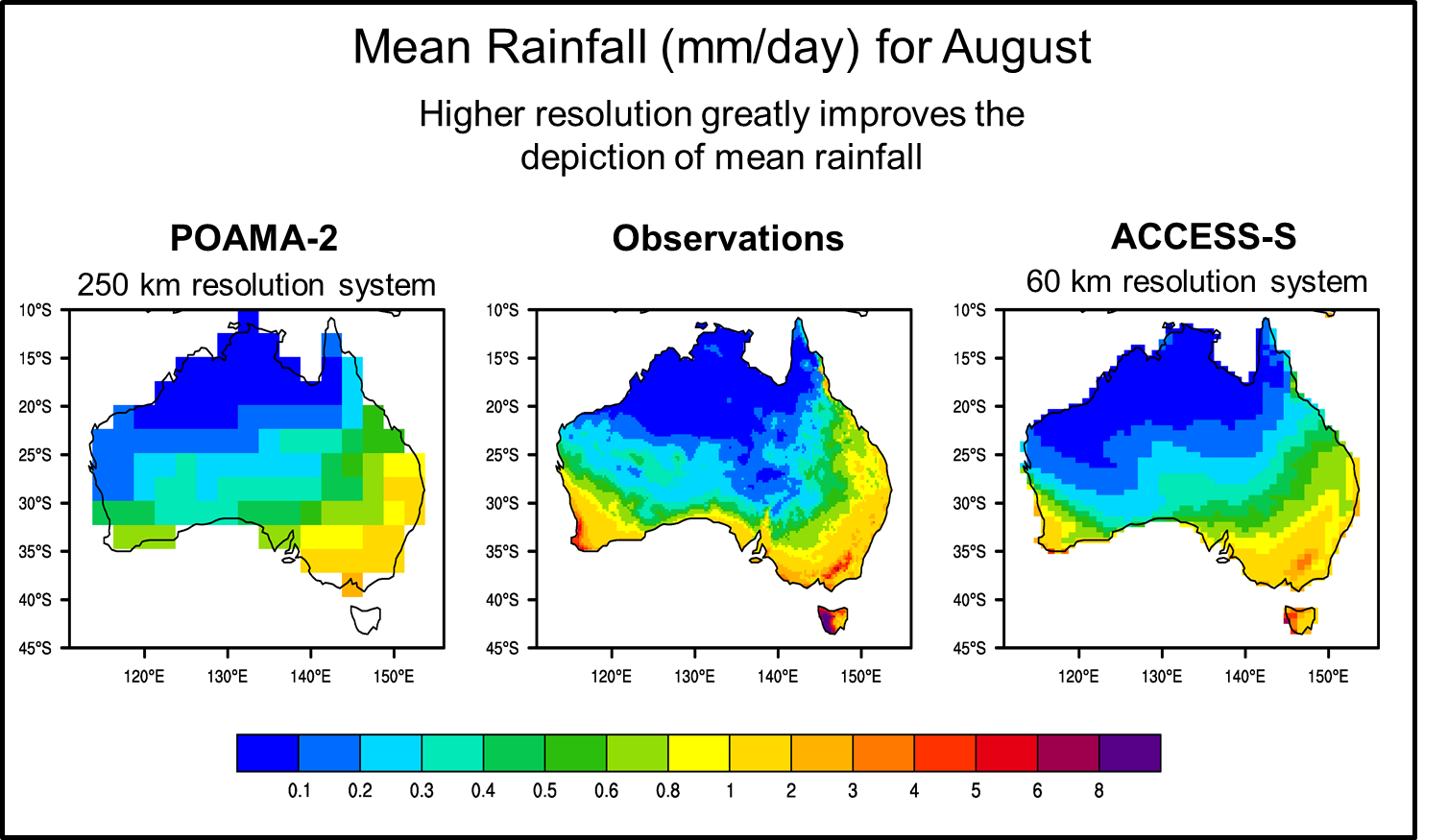In recent years the Bureau’s seasonal climate outlooks have become more skilful, more useful and more popular. However, our present system, POAMA-2, is low-resolution (250km) and somewhat dated relative to systems operated by the leading meteorological centres abroad. Therefore, we are in the process of upgrading POAMA-2 with a new seasonal forecasting system referred to as ACCESS-S (the seasonal prediction version of ACCESS). ACCESS-S will operate at a 60 km resolution, compared to the 250 km resolution of POAMA-2, and will run on the Bureau’s new supercomputer. This brings POAMA and seasonal prediction into the national ACCESS modelling framework, which utilises the latest local and overseas developments.
One of the key partners in ACCESS is the UK Met Office (UKMO), with whom we have strong collaboration in weather forecasting. The development of ACCESS-S will strengthen our collaboration with the UKMO by extending our partnership to include seasonal prediction and allow us to leverage the latest developments from overseas more rapidly.
The table below highlights some of the major differences between POAMA-2 and ACCESS-S.
| POAMA-2 | ACCESS-S | |
|---|---|---|
| Atmospheric model | Bureau Atmospheric Model (BAM)
~10 years old |
Latest UK MetOffice atmospheric model GC2 |
| Atmospheric resolution | Horizontal: 250 km (T47)
Vertical: 17 levels (does not extend into the stratosphere) |
Horizontal: 60 km in the midlatitudes (N216)
Vertical: 85 levels (extending into the stratosphere) |
| Land surface model | Simple bucket model for soil moisture and 3-layers for soil temperature. | State-of-the-art land surface model (JULES) with 4 soil levels. Sophisticated representation of soil and surface hydrology and of fluxes of heat and moisture within the soil and to the atmosphere. Land cover heterogeneity is represented. |
| Ocean model | Modular Ocean Model (MOM version 2).
~13 years old |
Latest NEMO model from France which is part of the UK MetOffice coupled model GC2 |
| Ocean resolution | Horizontal: ~200 km x 100 km
Vertical: 25 levels; level thicknesses range from 15 m near the surface to almost 1000 m near the bottom |
Horizontal: 25 km
Vertical: 75 levels; level thicknesses range from 1 m near the surface to about 200 m near the bottom (6000m depth) |
| Model Physics | >10 years old | Latest from UK MetOffice and France |
One of the most obvious improvements with ACCESS-S will be forecasts with more regional detail. At the moment the spatial resolution of our forecasts is 250 km. In ACCESS-S the resolution will be 60 km in the Australian region. At this resolution the model will be able to, for example, differentiate between the climates of western and eastern Tasmania and will better represent the Great Dividing Range, which plays a key role in the spatial distribution of rainfall. Increased resolution will also improve the representation of important large-scale climate drivers, like ENSO, potentially leading to better multi-week and seasonal forecast accuracy over Australia.


As shown in the table above, ACCESS-S will also have a considerably higher resolution in the ocean. This could be highly beneficial for our marine stakeholders, and also open the door for new applications. The animation below is from an ocean forecast with ACCESS-S and shows the remarkable fine-scale detail that the model is capable of capturing.

Animation of daily sea surface temperature from an ACCESS-S forecast. Although this animation is focussed on the Australian region, the ocean model does have a global domain.
The coupled model in ACCESS-S will be the same coupled model that is used for seasonal prediction at the UKMO. However, we are not simply importing the UKMO seasonal prediction system - a prediction system is more than just the model. In fact, our strategy is no different to what it has been in the past. We have always relied on modelling components developed internationally. This is common practise, since there are only a handful of these complex models available worldwide. So, we are taking the UKMO coupled model and entering into a joint partnership to develop it under the ACCESS framework. In order to satisfy our stakeholders and meet our Bureau service needs, we will need to have both a larger hindcast set and ensemble size (for hindcasts and real-time forecasts) than used at the UKMO and will need to make the ensemble generation appropriate for multi-week forecasts. For ACCESS-S version 2, we will also be adding our own data assimilation and will be extending forecasts out to 5-years lead time in order to investigate the potential for multi-year forecasting. Going forwards, we will be playing a significant role in contributing to the development of the UKMO model, specifically focussing on atmospheric and oceanic processes that are critical to the Australian region.
References:
Hudson, D., Alves, O., Hendon, H.H., Lim, E., Liu, G., Luo J.-J., MacLachlan, C., Marshall, A.G., Shi, L., Wang, G., Wedd, R., Young, G., Zhao, M., Zhou X., 2017: ACCESS-S1: The new Bureau of Meteorology multi-week to seasonal prediction system. Journal of Southern Hemisphere Earth Systems Science, 67:3 132-159 doi: 10.22499/3.6703.001.